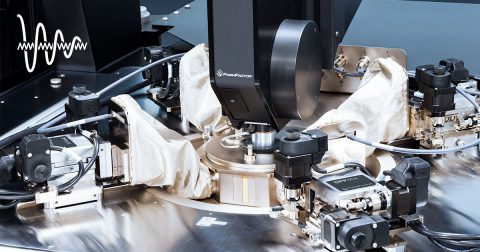In a few recent posts, we’ve highlighted unique aspects of the CM300xi-ULN probe station. To recap:
In this post we’ll cover achieving high throughput flicker noise measurements. Flicker and RTN noise testing can take a long time, especially when measuring down to frequencies of 1 Hz or below. Sweep times up to 30 min at a single temperature are common. And standard data collection for device models requires DUT data at multiple temperatures on small pads.
To lower Cost of Test (CoT), and significantly increase on-wafer test throughput, automation can be added to a test setup using four different methods:
- Automatic wafer loading
- Motorized probe positioners for small pad touchdown optimization
- Automatic thermal transitions with probe-to-pad-alignment
- Multi-DUT layout automation
For addressing method 1, a standard production prober can be used to increase data collection throughput, but these probers are designed for high-speed production test, not high accuracy flicker noise measurements. The resulting data accuracy is severely compromised by prober noise.
For solving methods 2, 3 and 4, significant technology development – optical, mechanical and software – is required to switch away from slow, manual probe positioning.
In all cases, it is important to note that the automation methods must not compromise TestCell low-noise performance by adding or transmitting unwanted noise into the probing environment. This has been a common problem with traditional approaches that add non-optimized thermal control, hardware and electronics modules.
Adding our Autonomous DC Measurement Assistant to the CM300xi-ULN probe system creates a paradigm shift for engineers and lab managers setting up flicker noise testing. It is now possible to setup a high throughput TestCell, for both semi – or fully-automatic CM300xi-ULN systems, offering complete hands-free 24/7 operation.
The Autonomous DC Measurement Assistant combines motorized probe positioners with state-of-the-art image processing to achieve highly-reliable measurement data at any time. It enables small pad touchdown optimization, automatic testing over multiple different temperatures, and automatic probe layout spacing for testing sub die. All capabilities are optimized to ensure ultra-low noise performance is not compromised.
Both single-DUT probe layouts and multi-DUT layouts can be easily called by measurement software for complete automation. The Autonomous DC Measurement Assistant takes care of all the complex management of thermal transitions, and thermal soak time optimization of probe-to-pad-alignment (PTPA). The result is ultra-low noise probing, with low contact resistance on small pads down to 30 μm, for any flicker noise modelling and extended temperatures (-55 to 200°C), over all dies on a wafer, and all wafers.
For more information on the CM300xi-ULN probe system, visit the website or download the data sheet here.
